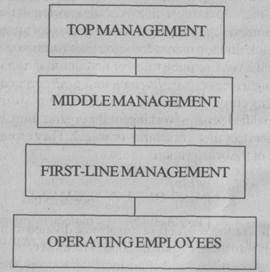Levels and Areas of Management
1. LEVELS OF MANAGEMENT
Each organization can be represented as a three-story structure or a pyramid. Each story corresponds to one of the three general levels of management: top managers, middle managers, and first-line managers. At the basic level of this pyramid there are operating employees.

A top manager is an upper-level executive who guides and controls the overall activities of the organization. Top managers
constitute a small group. They are generally responsible for the organization's planning and developing its mission. They also determine the firm's strategy and its major policies. It takes years of hard work as well as talent and good luck, to reach the ranks of top managers. They are president, vice president, chief executive officer, and member of the Board.
A middle manager is a manager who implements the strategy and major policies handed down from the top level of the organization. Middle managers develop tactical plans, policies, and standard operating procedures, and they coordinate and supervise the activities of first-line managers. Titles at the middle-management level include division manager, department head, plant manager, and operations manager.
A first-line manager is a manager who coordinates and supervises the activities of operating employees. First-line managers spend most of their time working with employees, answering questions, and solving day-to-day problems. Most first-line managers are former operating employees who, owing to their hard work and potential, were promoted into management. Many of today's middle and top managers began their careers on this first management level. Common titles for first-line managers include office manager, supervisor, foreman and project manager.
Operating employees are not managers. They are qualified and non-qualified persons working for the organization. For their labour or services they get salaries or wages. They represent the work force of the organization.
2. AREAS OF MANAGEMENT
An organizational structure can also be divided more or less horizontally into areas of management. The most common areas are finance, operations, marketing, human resources, and administration. Depending on its purpose and mission, an organization may include other areas as well—research and development, for example, or risk management.

A financial manager is primarily responsible for the organization's financial resources. Accounting and investment are specialized areas within financial management. Because financing affects the operation of the entire firm, many of the presidents of the largest companies are people who got their "basic training" as financial managers.
An operations manager creates and manages the systems that convert resources into goods and services. Traditionally, operations management is equated with the production of goods. However, in recent years many of the techniques and procedures of operations management have been applied to the production of services and to a variety of nonbusiness activities. Like financial management, operations management has produced a good percentage of today's company presidents.
A marketing manager is responsible for the exchange of products between the organization and its customers or clients. Specific areas within marketing are marketing research, advertising, promotion, sales, and distribution.
A human resources manager is in charge of the organization's human resources programs. He or she engages in human resources planning, design systems for hiring, training, and appraising the performance of employees, and ensures that the organization follows government regulations concerning employment practices.
An administrative manager (also called a general manager) is not associated with any specific functional area but provides overall administrative leadership. A hospital administrator is a good example of an administrative manager. He or she does not specialize in operations, finance, marketing, or human resources management but instead coordinates the activities of specialized managers in all these areas.
Exercises
